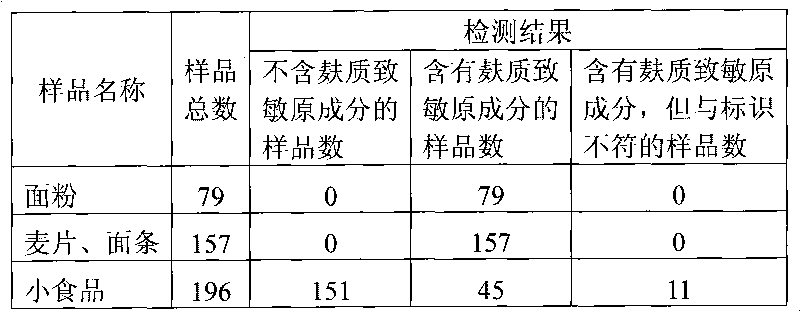Primer, probe and kit of detecting real-time fluorescence PCR of four allergen gluten components in foods and detection method
A technology for detecting primers and allergenic bran, applied in biochemical equipment and methods, fluorescence/phosphorescence, material excitation analysis, etc., can solve the problems of pollution, low PCR specificity, etc., to prevent pollution, reduce detection costs, improve The effect of detection efficiency and sensitivity
- Summary
- Abstract
- Description
- Claims
- Application Information
AI Technical Summary
Problems solved by technology
Method used
Image
Examples
Embodiment 1
[0042] 1. Design of primers and probes for real-time fluorescent PCR detection of food allergen gluten
[0043]According to the results of homologous gene screening and comparison, barley housekeeping gene Hordein (SEQ ID NO.13), wheat housekeeping gene Gliadin (SEQ ID NO.14), rye housekeeping gene Sec1 (SEQ ID NO. .15) and the oat housekeeping gene Avenin (SEQ ID NO.16) are target genes for detection and amplification. According to the nucleic acid sequences of the above-mentioned genes published on NCBI, and through comprehensive consideration of factors such as the consistency of the annealing temperature of the detection primers and probes and the similarity of GC content, the following specific primers and probes were designed:
[0044] ① The detection primers and probe sequences of the barley (Barley) Hordein gene are:
[0045] Forward primer (SEQ ID NO.1): 5′-AAC AGC TAA ACC CAT GCA AGG TA-3′
[0046] Reverse primer (SEQ ID NO.2): 5′-GTT CGG GGA TTT GGG GTA GTT G-3′ ...
Embodiment 2
[0096] Embodiment 2, specificity test
[0097] Samples of gluten allergen components such as barley, wheat, oat and rye were detected by using the detection kit and detection method containing specific primers and probes in Example 1. Simultaneous detection of white sesame, brown rice, mung bean, corn, black soybean, snow pea, Thai basmati rice, pinto bean, black adzuki bean, soybean, pea, rice bean, black rice, carrot, Chinese cabbage, leek, rape, peanut, sorghum , barley and other non-gluten allergen components DNA samples to evaluate the specificity of the method, the test results are as follows.
[0098] The results of the negative control showed that no fluorescent signal was detected in the FAM channel, indicating that the reaction result was normal and the reaction system was free from pollution. The results of the positive control showed that the FAM channel had a fluorescent signal detected, and the reaction result was normal.
[0099] The detection results of the g...
Embodiment 3
[0105] Embodiment 3, sensitivity test
[0106] 1. Detection sensitivity of gluten allergens in food of plant origin
[0107] Using rice flour (with a gluten concentration of 50 mg / kg) as a gluten allergen reference material, the method in Example 1 was used to detect the sensitivity of the method. The test results show that the negative control test results show that there is no fluorescent signal detected in the FAM channel, indicating that the reaction result is normal and the reaction system is free of pollution; the positive control test result shows that the FAM channel has a fluorescent signal detected, and the reaction result is normal; the sample test result shows that , the gluten allergen reference material with a concentration of 50mg / kg can be detected well.
[0108] The results showed that the standard method had a high detection sensitivity of 50mg / kg for gluten allergens in food of plant origin.
[0109] 2. Detection sensitivity of gluten allergens in plant ra...
PUM
 Login to View More
Login to View More Abstract
Description
Claims
Application Information
 Login to View More
Login to View More - R&D
- Intellectual Property
- Life Sciences
- Materials
- Tech Scout
- Unparalleled Data Quality
- Higher Quality Content
- 60% Fewer Hallucinations
Browse by: Latest US Patents, China's latest patents, Technical Efficacy Thesaurus, Application Domain, Technology Topic, Popular Technical Reports.
© 2025 PatSnap. All rights reserved.Legal|Privacy policy|Modern Slavery Act Transparency Statement|Sitemap|About US| Contact US: help@patsnap.com

